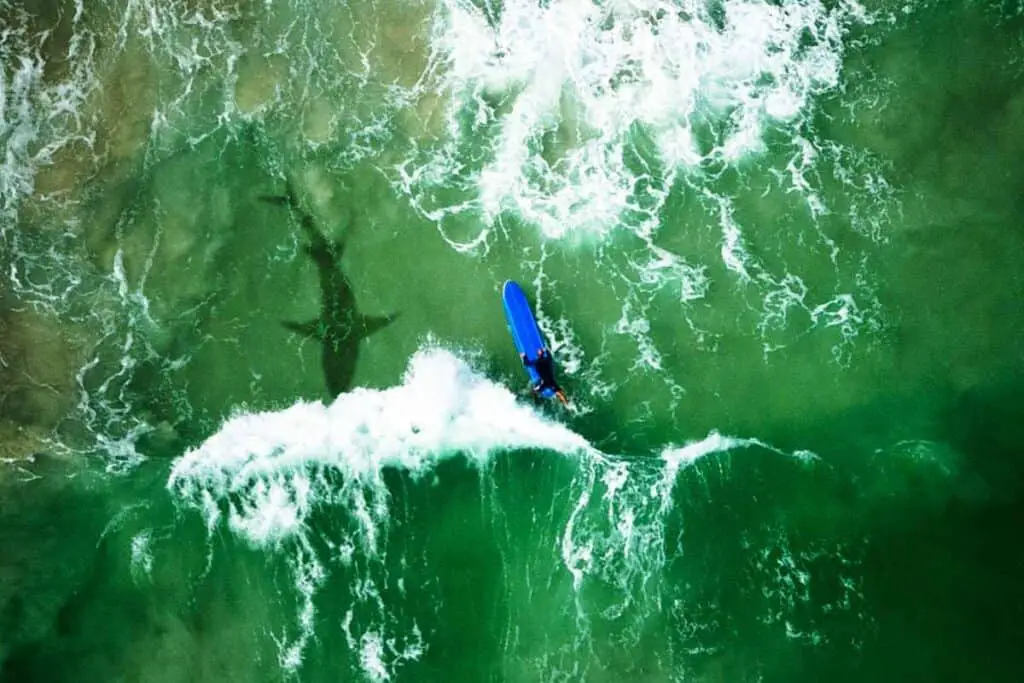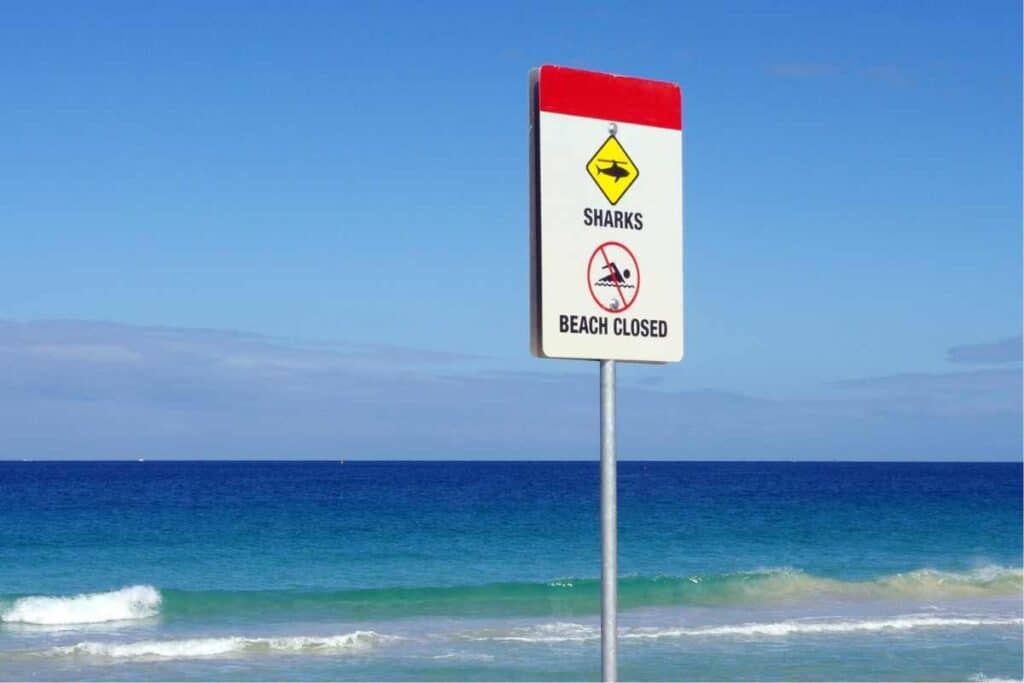When you’re out on the waves, the presence of a shark can be an unnerving experience.
It’s rare for sharks to pose a threat to surfers, but it’s important to know how to act if you find yourself in close proximity to one while surfing. Keeping your cool is crucial; a clear head will help you make sensible decisions.

If you spot a shark while on your board, it’s important to take stock of your surroundings. Sharks are generally not interested in humans, and encounters are often a case of curiosity rather than aggression. By understanding how to handle the situation, you can reduce the risk of turning an encounter into an incident.
The key is to avoid startling the shark with sudden moves. Sharks rely on the element of surprise, so if they realize they’ve been spotted, they are more likely to keep their distance.
Remain on your board if possible, as it provides a barrier between you and the shark. Maintain visual contact with the animal as you calmly and steadily move towards the shore, avoiding splashing.
Understanding Shark Behavior
When you’re out in the ocean, understanding the behavior of sharks is key to keeping yourself safe.

This knowledge helps you interpret their actions accurately and can be essential in encounters with these apex predators.
Identifying Shark Species
- Great White Shark: Recognized by its large size, conical snout, and stark white underbelly, the Great White is often solitary and can be curious about objects in the water.
- Tiger Shark: With distinctive dark stripes on a lighter body, similar to a tiger’s pattern, these sharks are known for their less discriminative appetite.
It’s vital to know which species of shark you’re dealing with, as behavior varies between them.
Great White Sharks are known as inquisitive predators and may be assessing you rather than seeing you as prey.
In contrast, Tiger Sharks, another species of large shark, are more opportunistic and can occasionally be a threat to surfers.
Shark Movement Patterns
Shark movements tend to be more active during feeding times, which often occur at dawn and dusk.
Here’s what to keep an eye out for:
- Erratic Swimming: A shark’s irregular movement might indicate agitation or confusion.
- Direct Approaches: A shark swimming straight toward you might be displaying territorial behavior or curiosity.
Sharks are integral parts of the marine ecosystem and are typically not interested in humans; they may approach out of curiosity rather than a desire to feed.
Your understanding of their behavior patterns can help you remain composed and take appropriate action if one comes close while you’re surfing.
Pre-Surf Preparation

Before heading out to the waves, it’s crucial to be proactive about safety and aware of your surroundings.
Taking some time to prepare can help reduce the risk of a shark encounter while you enjoy surfing.
Find out 🐶 Do Sharks Eat Dogs?
Check Local Shark Activity
Begin by checking recent shark sightings in the area you plan to surf. Many beaches provide shark activity reports online or at lifeguard stations. This can include:
- Recent Sightings: Look for any shark activity posted within the last 48 hours.
- Patterns: Are there times of day when sharks are more often spotted?
- Advisories: Follow any warnings or beach closures issued by local authorities.
Safety Gear and Deterrents

Equipping yourself with the right gear can make a significant difference in personal safety.
Consider these options:
- Ocean Guardian FREEDOM+ Surf: This is a device that you can attach to your surfboard, creating an electromagnetic field to deter sharks.
- Modom Shark Leash: This is a surfboard leash with a magnetic deterrent designed to reduce the risk of a shark encounter.
- NoShark: A deterrent band that you wear which emits electric fields to keep sharks away.
Always remember: No deterrent is 100% effective, but using one might reduce the likelihood of an encounter. Stay informed and equipped for a safer surfing experience.
Best Practices While Surfing
When you’re out on the waves, ensuring your safety along with enjoying the surf should be your top priorities.
Here’s how you can enhance your visibility and reduce encounters with sharks in known hotspots.
Staying Visible
- Wear brightly colored clothing: Opt for vivid, contrasting colors when choosing your surf gear. While sharks don’t see colors as vividly as humans, stark contrasts can help you stand out against the ocean backdrop.
- Avoid jewelry: Reflective surfaces like that of jewelry can mimic fish scales. Keep it at home to avoid drawing unnecessary attention.
Avoiding Risky Areas
- Be cautious near river mouths: These areas often have reduced visibility and can attract sharks.
- Know your regions: Familiarize yourself with shark activity in areas like Australia, South Africa, California, Florida, and the Gulf of Mexico.
- Mind the seasons and migrations: For instance, Newport Beach and the Island of Kauai have seasons with increased shark presence.
During a Shark Encounter

Encountering a shark while surfing can be a harrowing experience, but knowing the right steps to take can greatly increase your safety. Let’s focus on what you should do if you find yourself in this situation.
Stay Calm and Assess
First and foremost, stay calm. Your ability to keep your cool can make a big difference.
Take slow, deep breaths to maintain a clear head. Quickly but carefully observe the shark’s behavior; often, they may be simply passing by or curious rather than aggressive.
- Assess the situation:
- Is the shark displaying aggressive behavior?
- Are there multiple sharks?
- How far are you from the shore?
Defensive Actions
If the shark appears interested in you, resist any instinct to thrash around or make sudden movements. Instead, keep the shark within your line of sight. If it comes close, you can use a shark deterrent if you have one. As a last resort, if the shark becomes aggressive, gently push its nose to redirect it, as this can sometimes discourage further interest.
Non-aggressive Actions:
- Maintain eye contact with the shark
- Use any available shark deterrent like a shark shield
Aggressive Actions:
- Redirect the shark’s nose
- Create a barrier with your surfboard
Find out 🦈 Does Pee Attract Sharks?
Exiting the Water
Making a safe return to shore is your ultimate goal. Wait for a calm moment and then, move slowly and with purpose, avoiding panic.
If you’re close to other surfers or swimmers, group together; sharks are less likely to approach a group.
Once you get to the beach, seek help immediately if you have any injuries and alert others about the shark’s presence.
- How to Exit:
- Move smoothly and steadily towards shore
- Join a group if possible for a safer exit
Remember, while the risk of a shark encounter is low, staying informed and prepared can help ensure your surfing experience remains an enjoyable one.
Post-Encounter Actions
After a shark encounter while surfing, it’s important to ensure both your safety and that of others in the water. Taking the correct steps immediately afterward can help prevent further incidents.
Informing Authorities
Once you’re safely onshore, notify the nearest lifeguard about the encounter. If there isn’t a lifeguard present, contact local beach authorities or marine organizations to report the shark activity. This information is vital as they may need to:
- Close the beach: To prevent potential shark attacks.
- Post warning signs: To alert other beachgoers of recent shark presence.
Medical Care if Necessary
Even if you feel unharmed, it’s wise to seek medical attention to ensure no injuries have been overlooked. If you, or anyone else, have sustained a shark bite, immediate medical care is critical. Follow these steps:
- Apply pressure to the wound to stop bleeding.
- Call emergency services or have someone do it for you.
- Await professional medical responders: Do not attempt to transport serious injuries without professional assistance.


